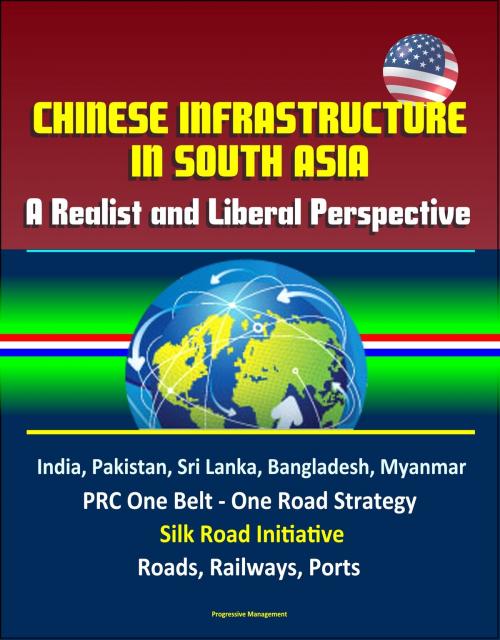Chinese Infrastructure in South Asia: A Realist and Liberal Perspective, India, Pakistan, Sri Lanka, Bangladesh, Myanmar, PRC One Belt - One Road Strategy, Silk Road Initiative, Roads, Railways, Ports
Nonfiction, History, Asian, India, China| Author: | Progressive Management | ISBN: | 9781370394647 |
| Publisher: | Progressive Management | Publication: | October 4, 2016 |
| Imprint: | Smashwords Edition | Language: | English |
| Author: | Progressive Management |
| ISBN: | 9781370394647 |
| Publisher: | Progressive Management |
| Publication: | October 4, 2016 |
| Imprint: | Smashwords Edition |
| Language: | English |
This important report has been professionally converted for accurate flowing-text e-book format reproduction. Since 2000, and with increased focus after the announcement of the One Belt, One Road initiative in 2015, China has led the development of a robust infrastructure program in South Asia. Despite being promoted by China as the creation of a win-win environment throughout the Indian Ocean region, realist scholars argue that China's motivations are to utilize this infrastructure to create overseas bases, threaten India's perceived sphere of influence, and increase Chinese influence by challenging the regional order. When viewed through a liberal lens, the initiative creates opportunities for common development, encourages multilateral growth, and addresses failures that current global and regional institutions have been unable to overcome. This study assesses both arguments and answers the question: Do China's motivations seem more consistent with a realist or liberal lens?
My research found that when assessed under a four-aspect framework that addresses the potential economic, geopolitical, and security-related effects of the initiative on South Asia, the liberal argument provided stronger evidence and produced a narrative more aligned with China's economic needs. By deciding through which lens to view China's motivations, great powers in the region can best assess how to address these programs and either challenge or support China.
This study is separated into six chapters. Following the Introduction, Chapter II provides background information on the OBOR strategy and documents China's infrastructure development within South Asia over the past 15 years. In addition, I introduce the four aspects that make up the framework of the thesis.
The Chapters III and IV assess these actions and attempt to explain Beijing's motivations based on a realist and liberal interpretation. Each chapter will present the material under a separate school of thought, beginning with realism in Chapter III and liberalism in the fourth. I will provide a brief background on the school of thought before interpreting Beijing's motives by utilizing the four-aspect framework.
The Chapter V is my assessment of the material and interpretation of China's motivation behind the OBOR strategy in South Asia. In the conclusion, Chapter VI, I summarize my findings and discuss the significance of these actions on South Asian relations and United States foreign policy while also addressing potential events that could alter my conclusion.
This important report has been professionally converted for accurate flowing-text e-book format reproduction. Since 2000, and with increased focus after the announcement of the One Belt, One Road initiative in 2015, China has led the development of a robust infrastructure program in South Asia. Despite being promoted by China as the creation of a win-win environment throughout the Indian Ocean region, realist scholars argue that China's motivations are to utilize this infrastructure to create overseas bases, threaten India's perceived sphere of influence, and increase Chinese influence by challenging the regional order. When viewed through a liberal lens, the initiative creates opportunities for common development, encourages multilateral growth, and addresses failures that current global and regional institutions have been unable to overcome. This study assesses both arguments and answers the question: Do China's motivations seem more consistent with a realist or liberal lens?
My research found that when assessed under a four-aspect framework that addresses the potential economic, geopolitical, and security-related effects of the initiative on South Asia, the liberal argument provided stronger evidence and produced a narrative more aligned with China's economic needs. By deciding through which lens to view China's motivations, great powers in the region can best assess how to address these programs and either challenge or support China.
This study is separated into six chapters. Following the Introduction, Chapter II provides background information on the OBOR strategy and documents China's infrastructure development within South Asia over the past 15 years. In addition, I introduce the four aspects that make up the framework of the thesis.
The Chapters III and IV assess these actions and attempt to explain Beijing's motivations based on a realist and liberal interpretation. Each chapter will present the material under a separate school of thought, beginning with realism in Chapter III and liberalism in the fourth. I will provide a brief background on the school of thought before interpreting Beijing's motives by utilizing the four-aspect framework.
The Chapter V is my assessment of the material and interpretation of China's motivation behind the OBOR strategy in South Asia. In the conclusion, Chapter VI, I summarize my findings and discuss the significance of these actions on South Asian relations and United States foreign policy while also addressing potential events that could alter my conclusion.















